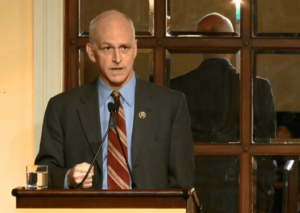The leader of the House Armed Services Committee (HASC) said Monday he sees “tough fights” ahead over President Biden’s proposals to cut the Navy’s nuclear-tipped sea-launched cruise missile (SLCM-N) program and retire B-83 gravity bombs as Congress takes up the next defense policy bill.
Rep. Adam Smith (D-Wash.), the HASC chair, said he agreed with both policy proposals and urged Congress to make “wise financial choices” as it relates to nuclear modernization funding priorities.

“So the things we’re going to fight about, we’re going to fight about the SLCM and we’re going to fight about the B-83, which is a big gravity nuclear bomb that President Biden wants to discontinue. We’ve got other munitions that are guided and strategic that meet that need,” Smith said during a Council on Foreign Relations discussion. “With the mood of Congress, I think those are going to be tough fights”
Smith said he viewed the SLCM-N program, which did not receive funding in the Navy’s fiscal year 2023 budget request, as “a mistake.”
“We have cruise missile capability in other legs. And if you were to put this onto attack submarines it would be complicated, difficult, it would undermine that mission, and I don’t think we should do it,” Smith said.
The Navy has said the proposal to cancel SLCM-N in the budget request was due to cost concerns and a view that the program could not be built on time, citing that move would save about $200 million in fiscal year 2023 and more than $2 billion over the next five years (Defense Daily, April 18).
Rep. Mike Rogers (R-Ala.), HASC’s top Republican, said earlier this month he believes Congress will reject the proposed cuts to SLCM-N and B-83, adding his view that “just talking about it is not helpful when you’re trying to deter aggression” (Defense Daily, May 2).
Smith noted his support for broader nuclear modernization efforts, while adding he believes he’s “100 percent lost” his argument in favor of getting rid of the ground-based leg of the nuclear triad.
“Look, it’s incredibly important that we modernize our nuclear force. It’s old. It’s aging. There’s different pieces to it. And the key cornerstones of that are the new nuclear-launching submarines, I think the Columbia-class [submarines] that we’re going to build and the new B-21 [bomber]. I mean, those are the most survivable legs. [And] we’re building a new Long-Range Standoff Weapon to give us a better cruise missile capability. I think all of those things are very important,” Smith said. “But the ground-based [leg], it’s in place, it’s an enormous sitting target that there’s no way we can protect, and it’s really expensive.”
The HASC chair did say the Air Force’s ongoing effort to field a new intercontinental ballistic missile to replace the Minuteman III is “a pretty good program,” while adding he doesn’t see the necessity.
“It’s actually doing what it’s supposed to do and it’s moving forward. I just don’t think we need it. But I lost that argument quite a while ago,” Smith said.
The Air Force recently dubbed the future ICBM program under development by Northrop Grumman [NOC] as the LGM-35A Sentinel, after it was previously called the Ground Based Strategic Deterrent (Defense Daily, April 5).